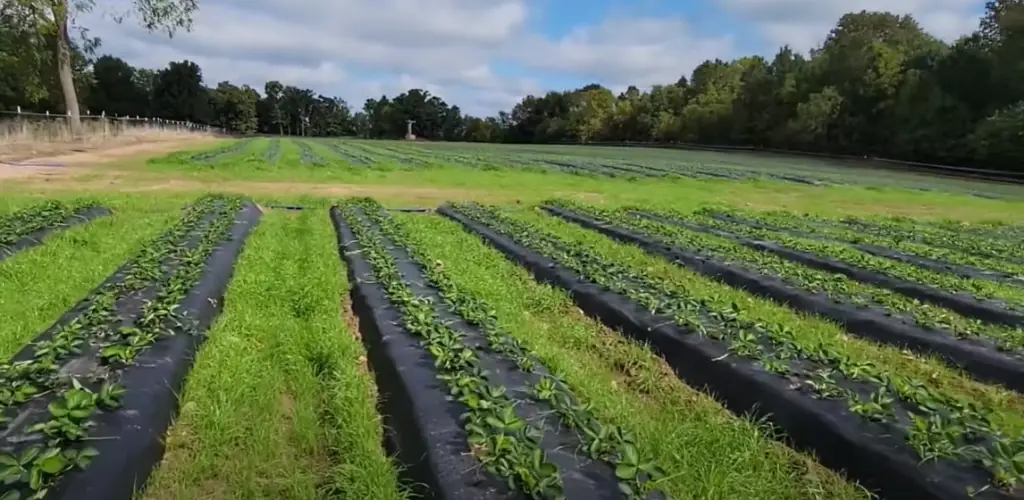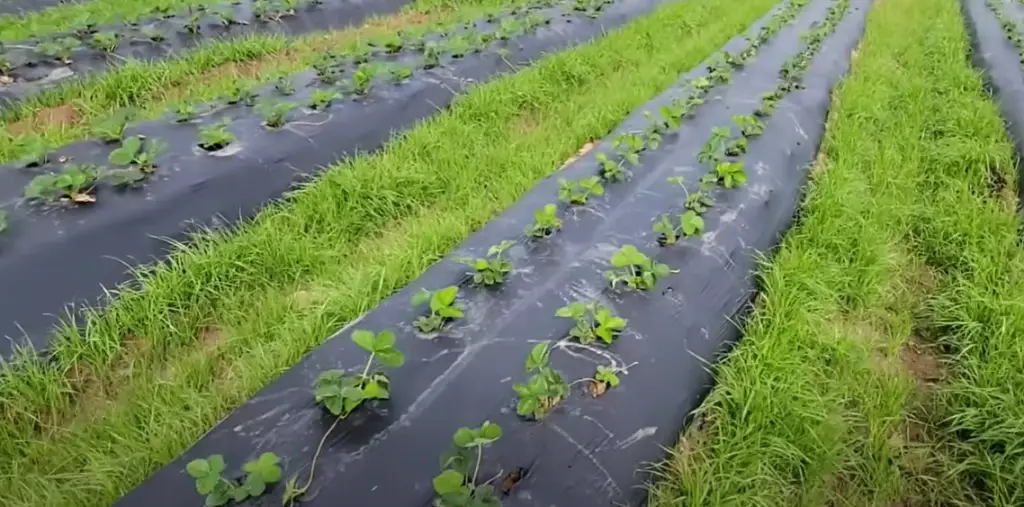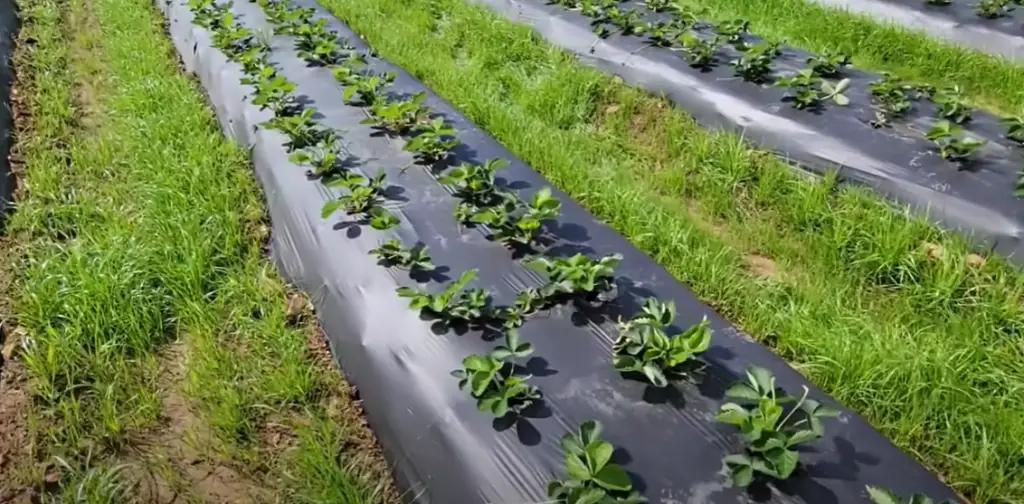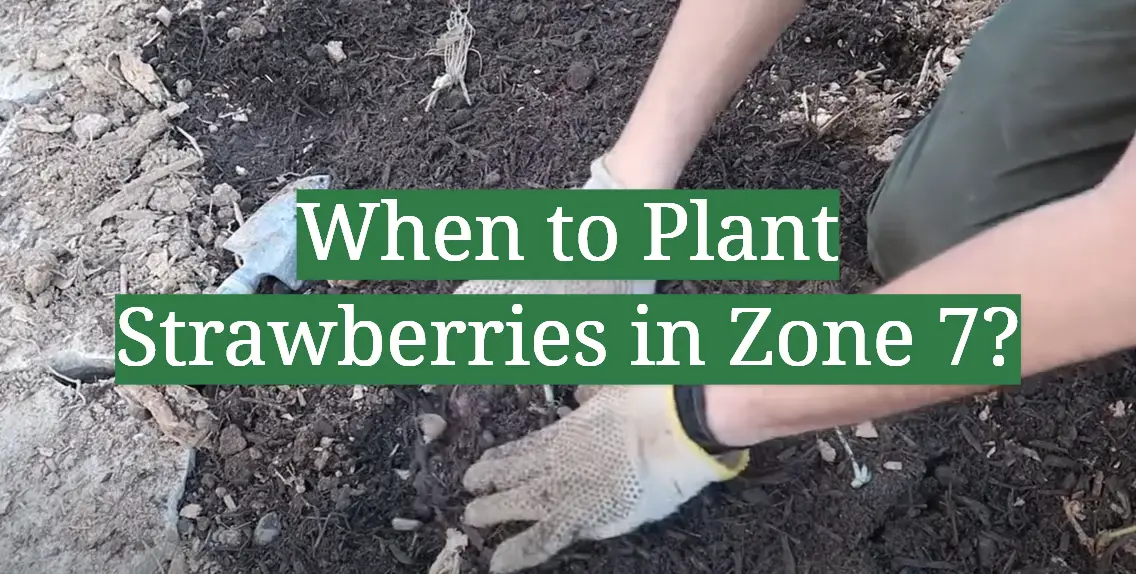Are you ready to get planting this season? Strawberries are a great choice for growing in zone 7. Tasty and easy to care for, they can provide sweet treats throughout the summer months – but knowing when to plant these luscious fruits is essential! This blog post will discuss the optimal times for planting strawberries in zone 7 so that you can reap the harvests of your efforts. From soil temperatures and winter quiescence periods through varieties of strawberry plants best suited to this climate – everything necessary for success will be discussed here! Read on and find out all there is to know about starting a quality strawberry patch in zone 7!
Growing Zone: What is It?
A growing zone is a geographic area that has similar climate conditions throughout the year. These areas are labeled by the USDA based on average temperatures and precipitation amounts in each region. Knowing what your local growing zone is can help you determine what plants will thrive in your garden or landscape. [1]
Plants have specific temperature and moisture requirements depending on where they grow naturally. Certain plants can only survive in warm climates, while others can handle cold temperatures better. Understanding the climate in your region and the types of plants that do well there will help you have a successful garden or landscape.
It’s important to consider both the hardiness zone and the heat zone when selecting plants for your garden or landscape. Also, local microclimates can affect the temperatures in your area. If your garden or landscape is located on a hillside or near a large body of water, it might have warmer temperatures than other places nearby. [2]

What are Special Characteristics of Zone 7?
Zone 7 is characterized by a wide range of climates and soil types. Gardeners in this zone should be aware that their plants will need extra care, as the climate can be very unpredictable. The summers tend to be quite hot and humid, while winters are usually mild. [3]
In Zone 7, you’ll find both deciduous and evergreen trees, as well as many varieties of shrubs and flowers. When choosing plants for this zone, it is important to consider their specific needs in relation to the climate. For example, some trees need more shade than others, while some flowers may require more moisture or nutrients than usual.
Plants that do well in Zone 7 include oaks, maples, flowering dogwood, rhododendron, azaleas, and holly. Other plants that can thrive in this zone include succulents, like agave and cacti; herbs like rosemary and thyme; and ornamental grasses such as fountain grass and pampas grass.
For gardeners in Zone 7, it is important to choose plants that are suited to the climate and soil type. With careful selection, you can create a beautiful garden that will thrive in this challenging zone. By researching the specific needs of each plant before planting, you’ll be sure to give your garden the best chance for success!
In addition to choosing plants that are well-suited to Zone 7’s climate and soil, it is also crucial to consider the amount of sunlight that each area will receive. Plants need at least six hours of direct sun every day in order to thrive. In addition, you should pay attention to soil moisture levels and provide supplemental irrigation if necessary. [4]

The Best Time to Plant Strawberries in Zone 7
Strawberries are a beloved treat that is easy to grow in most climates, including Zone 7. If you’re looking to plant strawberries in this zone, the best time to do so is during the late winter and early spring months of February through March.
This time frame provides ideal conditions for strawberry plants to take root and thrive. Planting too late in the season can leave the plants with too little time to mature before cooler temperatures arrive.
When planting strawberries in Zone 7, there is a number of factors to consider. They cover local climate, soil type and drainage.
- Climate
Zone 7 has a mild climate with an average of a few hard freezes each season. This means that the plants will need to be hardy enough to survive temperatures as low as 10 degrees Fahrenheit. Look for varieties specifically suited for Zone 7, such as Chandler or Sequoia, and ensure they are certified disease-free.
- Soil Type
The soil type in Zone 7 is often sandy, so you should use a nutrient-rich, well-draining soil that will help the strawberry plants thrive. Compost or manure can be used to enrich the soil and increase drainage.
- Drainage
Adequate drainage is essential for keeping strawberry roots healthy. To ensure optimal drainage, plant your strawberries on a sloped area or in raised beds. Mulching with straw is also beneficial to retain moisture and keep weeds at bay. [5]
How to Select the Type of Strawberry to Plant?
When selecting the type of strawberry to plant, there are several factors to consider. The most important factor is the climate in which you plan to grow your strawberries. Strawberries require a certain amount of cold weather to produce fruit, so it’s important to choose a variety that is well-suited for the climate and season length in your area.
Additionally, some varieties yield larger berries than others, so size considerations can come into play when selecting what type of strawberry to plant. If you’re growing strawberries for culinary purposes, it may be best to choose a variety with larger berries.
Finally, the amount of time and effort required to tend to a particular strawberry variety can also be an important factor in selecting the best type of strawberry for your garden. Some varieties are easier to maintain than others, so make sure you research how much time it will take to adequately care for any given variety before you commit to planting it in your garden. [6]

How to Grow Tasty and Juicy Strawberries?
Strawberries are one of the most popular fruits in the world and also a great choice for gardeners. Growing strawberries is easy, and with a little care and attention you can have delicious, juicy berries year round! Here’s how to get started:
Choose the right variety
There are many varieties of strawberries, and each one will grow slightly differently. Do some research to determine which type is best for your region and climate. Also consider the size and flavor you want from your berries!
Get the right soil
Strawberries need soil that is well drained and rich in organic matter. If your soil doesn’t meet these requirements, you may need to amend it with things like compost or peat moss. Additionally, strawberries prefer a slightly acidic soil, so adding sulfur may be necessary.
Planting
Strawberries should be planted in the spring, when there is no chance of frost. Planting them too early can cause the plants to die. Dig holes for each plant that are about 6-8 inches deep and 8-10 inches apart. Set each plant in its hole and cover with soil so that only the crown (where the leaves meet the stem) is visible.
Watering and Mulching
Strawberries need to be watered regularly, so make sure you are providing enough water for your plants. Also, consider mulching around the plants with hay or straw to help retain moisture. This can also help cut down on weeds that can compete with your strawberries for nutrients.
Harvesting
Once the berries are ripe, they should be harvested promptly. If you wait too long, they could become mushy and overripe. Pick them carefully so that you don’t damage the remaining fruits or flowers on the plant. Strawberries typically last up to one week in the refrigerator if kept dry and unwashed.

Other Considerations
Strawberries can be affected by pests and diseases, so make sure to monitor your plants regularly. Additionally, consider planting different varieties for cross-pollination or using companion plants like marigolds to attract pollinators and natural pest repellents. With a little work and care, you’ll soon have delicious strawberries! Enjoy! [7]
When Are Strawberries Ready To Harvest and How to Do It?
Strawberries are one of the most delicious and versatile fruits, which makes them a popular choice for gardeners all over the world. But when exactly are strawberries ready to harvest and how should you go about doing it? Read on to find out!
When Are Strawberries Ready To Harvest?
Most varieties of strawberry will be ripe for harvesting in late spring and early summer. The exact time will depend on the variety you’re growing, but you should generally see a bright red color when they’re ready. If you pick a strawberry before it’s ripe, it won’t ripen any further after being picked.
When strawberries are fully ripe, they can be picked and eaten straight away. This is the best time to enjoy their sweet flavor and juicy texture.
How to Harvest Strawberries?
Harvesting strawberries is a fairly simple process. The best way to do this is by using your fingers or a pair of scissors to gently remove the ripe fruit from the plant. Be sure not to pull on the stem, as this can damage the plant. Instead, try to just break off the strawberry carefully at its point of connection with the stem.
Once you’ve harvested your strawberries, be sure to eat them as soon as possible for the best flavor. If you won’t be eating them right away, store them in the refrigerator for up to a week or freeze them for future use. [8]
How to Store Strawberries?
Strawberries are delicate fruits, so proper storage is essential for ensuring they stay fresh and tasty. To maximize the life of your strawberries, store them in a cool, dry place away from direct sunlight or heat sources. Unwashed berries should be stored in an airtight container at temperature between 32°F and 40°F (0°C and 4.5°C). Do not store them near other fruits that emit ethylene gas, as this can cause the strawberries to over-ripen.
Before storing your berries, be sure to inspect them and discard any damaged or moldy ones. It is best to eat overly soft or mushy fruit right away. To wash the berries before storing, use cold water and gently pat them dry with a paper towel.
If you are not going to eat your strawberries right away, hull and slice them before storing. Place cut strawberries in an airtight container lined with several layers of paper towels at the bottom. This will help absorb any excess moisture that can cause mold growth. Keep in mind that once washed and sliced, strawberries should be eaten within two to three days.
When freezing strawberries, it is best to freeze them individually on a baking sheet before transferring to a freezer-safe container or resealable bag. Frozen strawberries can last up to six months in the freezer and still retain their flavor and nutritional value. If you plan on using the frozen berries for smoothies or baking, there is no need to thaw them first.
If you want to enjoy the flavor of strawberries year-round, consider preserving them using canning or jam-making methods. This way you can have fresh, homemade strawberry preserves on hand for whenever you need them. It is important to follow instructions carefully when preserving fruits to ensure they are safe for consumption later. [9]

How to Fertilize Strawberries?
Fertilizing your strawberry plants is a great way to improve their health and increase their productivity. To ensure the best results, it’s important to use the right fertilizer for your particular variety of strawberry plant. Here are some tips for fertilizing strawberries:
- Choose a fertilizer with an appropriate nitrogen-phosphorus-potassium (NPK) ratio for your strawberry plants. This will depend on the variety of strawberries you have, so check the label to make sure you’re using the right fertilizer.
- Apply the fertilizer in early spring when the soil is moist and warm. If possible, spread it out evenly around each plant. Make sure not to apply too much, as this can lead to burning or nutrient imbalances.
- Consider using an organic fertilizer for your strawberries, as this can help reduce the risk of nutrient pollution and other environmental problems. Organic fertilizers are usually less concentrated than traditional types, so you may need to apply more often.
- Test the soil in your strawberry patch periodically to make sure it’s not becoming overly acidic or nutrient deficient. Applying compost or other organic materials can help bring the soil back into balance if necessary.
- Water your strawberry plants regularly and thoroughly. This will ensure that the fertilizer is being absorbed by the plants and providing them with all the nutrients they need for healthy growth. [10]
FAQs
What month is best to plant strawberries?
The best time to plant strawberries is in the spring months. Depending on your region, this could be as early as March or April. Generally, you should wait until after the last frost to ensure that your plants don’t get damaged by cold temperatures. It’s also important to make sure that the soil temperature is warm enough for the seeds to germinate and grow successfully. Planting in the later spring months, such as May or June, can give your plants more time to develop before the temperatures start to get too hot.
What temperature is best for growing strawberries?
The ideal temperature for growing strawberries is between 55°F (13°C) and 75°F (24°C). For optimal results, it’s best to keep the high temperatures during the day when the plants are actively photosynthesizing and low temperatures at night when they are resting. When temperatures exceed 85°F (29°C), strawberry plants can suffer from heat stress, causing the flavor of the fruit to be diminished. Since strawberries are sensitive to cold temperatures, it is important to make sure that nighttime temperatures stay above 32°F (0°C). If temperatures drop below freezing for an extended period of time, strawberry plants can sustain serious damage and possibly die.
What is the fastest growing strawberry?
The fastest growing strawberry variety is the “Albion” variety. This type of strawberry grows quickly and produces large, juicy berries with a sweet flavor. It is also resistant to common fungal diseases that can affect other varieties of strawberries. Albion strawberries can be harvested in as little as three weeks after planting, making them an ideal choice for home gardeners who want to get the most out of their crop. They also produce a large amount of fruit for their size, making them a great addition to any garden.
For those looking for an even faster-growing strawberry variety, there are several hybrid varieties available that have been specifically bred for fast growth and high yields. These hybrids often produce larger berries with sweet flavor profiles, so they are also a good choice for those wanting to maximize their crop. They tend to be more expensive than traditional varieties, however, and may not be the best choice for smaller gardens or those on a budget. Hybrid strawberries are typically harvested in just two weeks after planting.
What is the best pollinator for strawberries?
The best pollinators for strawberry plants are honey bees due to their abundance, hardiness, and strong homing instinct. Honey bees also provide a more reliable pollenation because of their large numbers and ability to cover a larger area than solitary bee species. While bumblebees are often seen pollinating strawberries, they tend to be less efficient in terms of pollination.
In addition to honey bees, small native bee species and syrphid flies are also effective pollinators of strawberries. Syrphid flies, or hoverflies, are especially efficient pollinators due to their quick flight patterns and large amount of pollen they can transfer during each visit. Native bee species provide an invaluable service as well, with some species being able to travel up to 3 miles in search of food and pollen.
Useful Video: How To Plant Strawberries: Zone 7 Northern Virgina
To Sum Up
Planting strawberries in Zone 7 can be a rewarding experience for gardeners seeking healthful, homegrown produce. You should research what type of strawberry plants grow best in your area, as this will help ensure that the variety you choose is well suited to your landscape. When deciding when to plant them, mid-spring is the ideal time once the frost has passed and while avoiding the hot summer months. If you follow these simple steps, you’ll find that growing healthy strawberries that burst with flavor is not only possible but incredibly satisfying! Don’t forget to invest in suitable soil and plan for sufficient sun exposure or your strawberry vegetation may suffer. With adequate care and patience, gardening enthusiasts located in Zone 7 can easily enjoy delicious, tasty strawberries without having to travel far from home!
References:
- https://www.plantingtree.com/pages/hardiness-growing-zones
- https://www.gardeningknowhow.com/planting-zones/what-do-hardiness-zones-mean.htm
- https://www.fast-growing-trees.com/pages/growing-zones-guide-zone-7
- https://www.masterclass.com/articles/zone-7-plants-guide
- https://www.allaboutgardening.com/zone-7-strawberries/
- https://www.wikihow.life/Buy-a-Strawberry-Plant
- https://www.1millionwomen.com.au/blog/growing-sweetest-strawberries/
- https://www.almanac.com/plant/strawberries
- https://www.realsimple.com/food-recipes/shopping-storing/food/how-to-store-strawberries
- https://www.bhg.com/how-and-when-to-fertilize-strawberries-7555579










Leave a Reply
View Comments